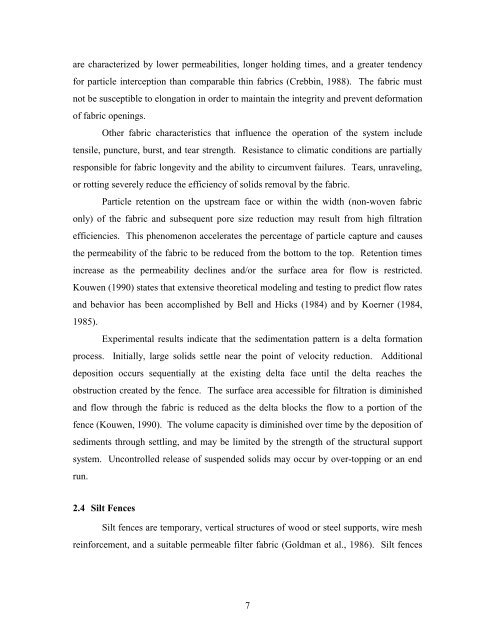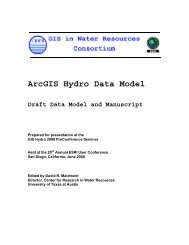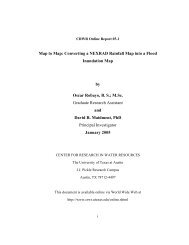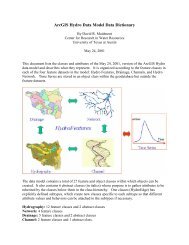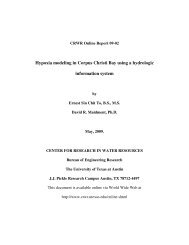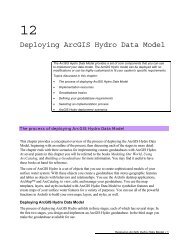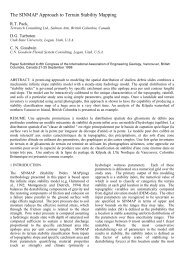View the Whole Report - Center for Research in Water Resources ...
View the Whole Report - Center for Research in Water Resources ...
View the Whole Report - Center for Research in Water Resources ...
Create successful ePaper yourself
Turn your PDF publications into a flip-book with our unique Google optimized e-Paper software.
are characterized by lower permeabilities, longer hold<strong>in</strong>g times, and a greater tendency<br />
<strong>for</strong> particle <strong>in</strong>terception than comparable th<strong>in</strong> fabrics (Crebb<strong>in</strong>, 1988). The fabric must<br />
not be susceptible to elongation <strong>in</strong> order to ma<strong>in</strong>ta<strong>in</strong> <strong>the</strong> <strong>in</strong>tegrity and prevent de<strong>for</strong>mation<br />
of fabric open<strong>in</strong>gs.<br />
O<strong>the</strong>r fabric characteristics that <strong>in</strong>fluence <strong>the</strong> operation of <strong>the</strong> system <strong>in</strong>clude<br />
tensile, puncture, burst, and tear strength. Resistance to climatic conditions are partially<br />
responsible <strong>for</strong> fabric longevity and <strong>the</strong> ability to circumvent failures. Tears, unravel<strong>in</strong>g,<br />
or rott<strong>in</strong>g severely reduce <strong>the</strong> efficiency of solids removal by <strong>the</strong> fabric.<br />
Particle retention on <strong>the</strong> upstream face or with<strong>in</strong> <strong>the</strong> width (non-woven fabric<br />
only) of <strong>the</strong> fabric and subsequent pore size reduction may result from high filtration<br />
efficiencies. This phenomenon accelerates <strong>the</strong> percentage of particle capture and causes<br />
<strong>the</strong> permeability of <strong>the</strong> fabric to be reduced from <strong>the</strong> bottom to <strong>the</strong> top. Retention times<br />
<strong>in</strong>crease as <strong>the</strong> permeability decl<strong>in</strong>es and/or <strong>the</strong> surface area <strong>for</strong> flow is restricted.<br />
Kouwen (1990) states that extensive <strong>the</strong>oretical model<strong>in</strong>g and test<strong>in</strong>g to predict flow rates<br />
and behavior has been accomplished by Bell and Hicks (1984) and by Koerner (1984,<br />
1985).<br />
Experimental results <strong>in</strong>dicate that <strong>the</strong> sedimentation pattern is a delta <strong>for</strong>mation<br />
process. Initially, large solids settle near <strong>the</strong> po<strong>in</strong>t of velocity reduction. Additional<br />
deposition occurs sequentially at <strong>the</strong> exist<strong>in</strong>g delta face until <strong>the</strong> delta reaches <strong>the</strong><br />
obstruction created by <strong>the</strong> fence. The surface area accessible <strong>for</strong> filtration is dim<strong>in</strong>ished<br />
and flow through <strong>the</strong> fabric is reduced as <strong>the</strong> delta blocks <strong>the</strong> flow to a portion of <strong>the</strong><br />
fence (Kouwen, 1990). The volume capacity is dim<strong>in</strong>ished over time by <strong>the</strong> deposition of<br />
sediments through settl<strong>in</strong>g, and may be limited by <strong>the</strong> strength of <strong>the</strong> structural support<br />
system. Uncontrolled release of suspended solids may occur by over-topp<strong>in</strong>g or an end<br />
run.<br />
2.4 Silt Fences<br />
Silt fences are temporary, vertical structures of wood or steel supports, wire mesh<br />
re<strong>in</strong><strong>for</strong>cement, and a suitable permeable filter fabric (Goldman et al., 1986). Silt fences<br />
7


